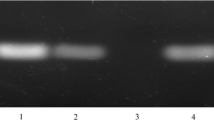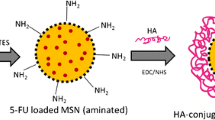Abstract
Metformin (Metf), a biguanide widely used to manage type 2 diabetes mellitus, has recently entered the spotlight as a hopeful anti-tumor agent. In this work, because of the hyaluronic acid (HA) capability to specifically target CD44 receptors over-expressed on the surface of non-small lung cancer cells, a tumor-targeted drug delivery nanocarrier-based HA-coated mesoporous silica nanoparticles (MSNs) have been used for active targeting and efficient delivery of Metf. For this purpose, the synthesized MSNs-HA were characterized using BET, FE-EM, DLS, and FTIR. Confocal microscopy was applied to show the enhanced cellular uptake of the FITC-labelled MSNs-HA compared to MSNs without HA coating. MTT and qPCR results also revealed superior cytotoxicity and pro-apoptotic effects of Metf-loaded MSNs-HA (Metf@MSNs-HA) against the A549 lung cancer cells compared to the free Metf and MSNs@Metf due to the efficient CD44-targeting capability and delivery of Metf@MSNs-HA. Besides, it was demonstrated that Metf@MSNs-HA could effectively trigger the AMP-activated protein kinase α (AMPKα) pathway and inhibit the mammalian target rapamycin (mTOR), increasing the growth suppression. In conclusion, this preliminary work disclosed the great potential of Metf@MSNs-HA in targeted therapy of lung cancer cells.







Similar content being viewed by others
Data Availability
The data that support the findings of this study are available from the corresponding author, upon reasonable request.
References
Low, Z. Y., Farouk, I. A., & Lal, S. K. (2020). Drug repositioning: New approaches and future prospects for life-debilitating diseases and the COVID-19 pandemic outbreak. Viruses, 12(9), 1058.
Alibakhshi, A., et al. (2016). An update on phytochemicals in molecular target therapy of cancer: Potential inhibitory effect on telomerase activity. Current Medicinal Chemistry, 23(22), 2380–2393.
Javidfar, S., et al. (2018). The inhibitory effects of nano-encapsulated metformin on growth and hTERT expression in breast cancer cells. Journal of Drug Delivery Science and Technology, 43, 19–26.
Jafari-Gharabaghlou, D., et al. (2018). Combination of metformin and phenformin synergistically inhibits proliferation and hTERT expression in human breast cancer cells. Iranian Journal of Basic Medical Sciences, 21(11), 1167.
Chatran, M., et al. (2018). Synergistic anti-proliferative effects of metformin and silibinin combination on T47D breast cancer cells via hTERT and cyclin D1 inhibition. Drug Research, 68(12), 710–716.
Aljofan, M., & Riethmacher, D. (2019). Anticancer activity of metformin: a systematic review of the literature. Future Science OA, 5(8), FSO410.
Ugwueze, C. V., et al. (2020). Metformin: a possible option in cancer chemotherapy. Analytical Cellular Pathology, 2020.
Wink, K. C., et al. (2016). Improved progression free survival for patients with diabetes and locally advanced non-small cell lung cancer (NSCLC) using metformin during concurrent chemoradiotherapy. Radiotherapy and Oncology, 118(3), 453–459.
Fatehi Hassanabad, A., & MacQueen, K. T. (2021). Molecular mechanisms underlining the role of metformin as a therapeutic agent in lung cancer. Cellular Oncology, 44(1), 1–18.
Ahmadi, S., et al. (2021). Efficient osteoblastic differentiation of human adipose-derived stem cells on TiO2 nanoparticles and metformin co-embedded electrospun composite nanofibers. Journal of Drug Delivery Science and Technology, 66, 102798.
Cetin, M., & Sahin, S. (2016). Microparticulate and nanoparticulate drug delivery systems for metformin hydrochloride. Drug Delivery, 23(8), 2796–2805.
Pourpirali, R., et al. (2021). Prolonged proliferation and delayed senescence of the adipose-derived stem cells grown on the electrospun composite nanofiber co-encapsulated with TiO2 nanoparticles and metformin-loaded mesoporous silica nanoparticles. International Journal of Pharmaceutics, 604, 120733.
Zavari-Nematabad, A., et al. (2017). Development of quantum-dot-encapsulated liposome-based optical nanobiosensor for detection of telomerase activity without target amplification. Analytical and Bioanalytical Chemistry, 409(5), 1301–1310.
Naseri, N., et al. (2018). An update on nanoparticle-based contrast agents in medical imaging. Artificial Cells, Nanomedicine, and Biotechnology, 46(6), 1111–1121.
Serati-Nouri, H., et al. (2020). Biomedical applications of zeolite-based materials: A review. Materials Science and Engineering: C, 116, 111225.
Mellatyar, H., et al. (2018). 17-DMAG-loaded nanofibrous scaffold for effective growth inhibition of lung cancer cells through targeting HSP90 gene expression. Biomedicine & Pharmacotherapy, 105, 1026–1032.
Mashayekhi, S., et al. (2020). Curcumin-loaded mesoporous silica nanoparticles/nanofiber composites for supporting long-term proliferation and stemness preservation of adipose-derived stem cells. International Journal of Pharmaceutics, 587, 119656.
Samadzadeh, S., et al. (2021). An implantable smart hyperthermia nanofiber with switchable, controlled and sustained drug release: Possible application in prevention of cancer local recurrence. Materials Science and Engineering: C, 118, 111384.
Tang, L., et al. (2021). Nanoparticle-mediated targeted drug delivery to remodel tumor microenvironment for cancer therapy. International Journal of Nanomedicine, 16, 5811.
Taleghani, A. S., et al. (2021). Mesoporous silica nanoparticles as a versatile nanocarrier for cancer treatment: A review. Journal of Molecular Liquids, 328, 115417.
Li, T., et al. (2019). Recent advancements in mesoporous silica nanoparticles towards therapeutic applications for cancer. Acta Biomaterialia, 89, 1–13.
Ahir, M., et al. (2020). Delivery of dual miRNA through CD44-targeted mesoporous silica nanoparticles for enhanced and effective triple-negative breast cancer therapy. Biomaterials Science, 8(10), 2939–2954.
Ricci, V., et al. (2018). Hyaluronated mesoporous silica nanoparticles for active targeting: Influence of conjugation method and hyaluronic acid molecular weight on the nanovector properties. Journal of Colloid and Interface Science, 516, 484–497.
Mo, X., et al. (2021). Hyaluronic acid-functionalized halloysite nanotubes for targeted drug delivery to CD44-overexpressing cancer cells. Materials Today Communications, 28, 102682.
Chen, C., et al. (2018). pH-responsive nanoreservoirs based on hyaluronic acid end-capped mesoporous silica nanoparticles for targeted drug delivery. International Journal of Biological Macromolecules, 111, 1106–1115.
Ghosh, S., et al. (2021). Targeted delivery of curcumin in breast cancer cells via hyaluronic acid modified mesoporous silica nanoparticle to enhance anticancer efficiency. Colloids and Surfaces B: Biointerfaces, 197, 111404.
Yu, M., et al. (2013). Hyaluronic acid modified mesoporous silica nanoparticles for targeted drug delivery to CD44-overexpressing cancer cells. Nanoscale, 5(1), 178–183.
Chen, Z., et al. (2013). Bioresponsive hyaluronic acid‐capped mesoporous silica nanoparticles for targeted drug delivery. Chemistry–A European Journal, 19(5), 1778–1783.
Sábio, R. M., et al. (2019). New insights towards mesoporous silica nanoparticles as a technological platform for chemotherapeutic drugs delivery. International Journal of Pharmaceutics, 564, 379–409.
Almalik, A., et al. (2017). Hyaluronic acid coated chitosan nanoparticles reduced the immunogenicity of the formed protein corona. Scientific Reports, 7(1), 1–9.
Jafari, S., et al. (2019). Mesoporous silica nanoparticles for therapeutic/diagnostic applications. Biomedicine & Pharmacotherapy, 109, 1100–1111.
Shukla, S. K., et al. (2019). Metformin-encapsulated liposome delivery system: An effective treatment approach against breast cancer. Pharmaceutics, 11(11), 559.
Rasouli, S., et al. (2020). Synergistic anticancer effects of electrospun nanofiber-mediated codelivery of curcumin and chrysin: Possible application in prevention of breast cancer local recurrence. Journal of Drug Delivery Science and Technology, 55, 101402.
Liu, K., et al. (2015). Hyaluronic acid-tagged silica nanoparticles in colon cancer therapy: Therapeutic efficacy evaluation. International Journal of Nanomedicine, 10, 6445.
Fang, Z., et al. (2019). Hyaluronic acid-modified mesoporous silica-coated superparamagnetic Fe3O4 nanoparticles for targeted drug delivery. International Journal of Nanomedicine, 14, 5785.
Gao, C., et al. (2020). Metformin induces autophagy via the AMPK-mTOR signaling pathway in human hepatocellular carcinoma cells. Cancer Management and Research, 12, 5803.
Lu, G., et al. (2021). The effects of metformin on autophagy. Biomedicine & Pharmacotherapy, 137, 111286.
Entezari, M., et al. (2022). AMPK signaling in diabetes mellitus, insulin resistance and diabetic complications: A pre-clinical and clinical investigation. Biomedicine & Pharmacotherapy, 146, 112563.
Acknowledgements
The authors would like to thank the “Department of Thoracic Surgery, Leshan People’s Hospital” for their kind cooperation.
Author information
Authors and Affiliations
Contributions
FZ and WL: methodology, investigation, data curation, original draft preparation. YL: writing – review and editing, formal analysis. HP: supervision, conceptualization, writing – review and editing.
Corresponding author
Ethics declarations
Ethical Approval
Not applicable.
Consent to Participate
Not applicable.
Consent for Publication
Not applicable.
Competing Interests
The authors declare no competing interests.
Additional information
Publisher's Note
Springer Nature remains neutral with regard to jurisdictional claims in published maps and institutional affiliations.
Supplementary Information
Below is the link to the electronic supplementary material.
Rights and permissions
Springer Nature or its licensor (e.g. a society or other partner) holds exclusive rights to this article under a publishing agreement with the author(s) or other rightsholder(s); author self-archiving of the accepted manuscript version of this article is solely governed by the terms of such publishing agreement and applicable law.
About this article
Cite this article
Zhang, F., Liu, W., Long, Y. et al. Targeted Delivery of Metformin Against Lung Cancer Cells Via Hyaluronan-Modified Mesoporous Silica Nanoparticles. Appl Biochem Biotechnol 195, 4067–4083 (2023). https://doi.org/10.1007/s12010-022-04289-6
Accepted:
Published:
Issue Date:
DOI: https://doi.org/10.1007/s12010-022-04289-6




